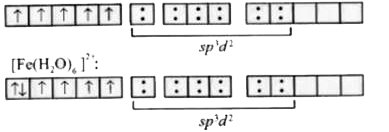Which of the following are outer orbital octahedral complexes?
A
[FeF6]3−
B
[Fe(CN)6]3−
C
[Fe(CN)4]2−
D
[Fe(H2O)6]2+
Text Solution
|
Topper's Solved these Questions
- COORDINATION COMPOUNDSBOOK - MTG-WBJEECHAPTER - COORDINATION COMPOUNDSEXERCISE - WB JEE Previous Years Questions (Category 1: Single Option Correct Type)
6 Videos
- COORDINATION COMPOUNDSBOOK - MTG-WBJEECHAPTER - COORDINATION COMPOUNDSEXERCISE - WB JEE Previous Years Questions (CATEGORY 3; ONE OR MORE THAN ONE OPTION CORRECT TYPE(
3 Videos
- COORDINATION COMPOUNDSBOOK - MTG-WBJEECHAPTER - COORDINATION COMPOUNDSEXERCISE - WBJEE/WORKOUT (Category 2: Single Option Correct Type)
13 Videos
- CHEMISTRY OF NON-METALLIC ELEMENTS AND THEIR COMPOUNDSBOOK - MTG-WBJEECHAPTER - CHEMISTRY OF NON-METALLIC ELEMENTS AND THEIR COMPOUNDSEXERCISE - WB JEE PREVIOUS YEARS QUESTIONS(CATEGORY 3 : One or More Option Correct Type)
1 Videos
- ENVIRONMENTAL CHEMISTRY BOOK - MTG-WBJEECHAPTER - ENVIRONMENTAL CHEMISTRY EXERCISE - WB JEE Previous Years Questions ( CATEGORY 1 : Single Option Correct Type )
2 Videos
Similar Questions
Knowledge Check
Which of the following are orter orbital octahedral complexes ?
A[FeF6]3−B[Fe(CN)6]4−C[Fe(CN)6]3−D[Fe(H2O)6]2+Atomic number of Mn,Fe,Co and Ni are 25, 26, 27 and 28 respectively. Which of the following outer orbital octahedral complexes have same number of unpaired electrons ?
A[MnCl6]3−B[FeF6]3−C[CoF6]3−D[Ni(NH3)6]2+Atomic number of Mn, Fe, Co and Ni are 25, 26, 27 and 28 respectively. Which of the following outer orbital octahedral complexes have same number of unpaired electrons ?
A[MnCl6]3−B[FeF6]3−C[CoF6]3−D[Ni(NH3)6]2+
Which of the following is outer orbital complex?
View SolutionWhich of the following is an outer orbital complex ?
View SolutionWhich of the following shall form an octahedral complex ?
View SolutionWhich of the following shell from an octahedral complex
View SolutionWhich of the following cation forms inner orbital octahedral complex with NH3 ?
View Solution

